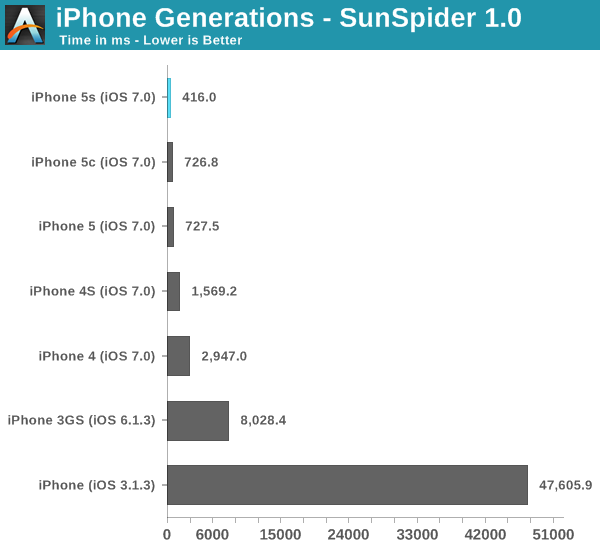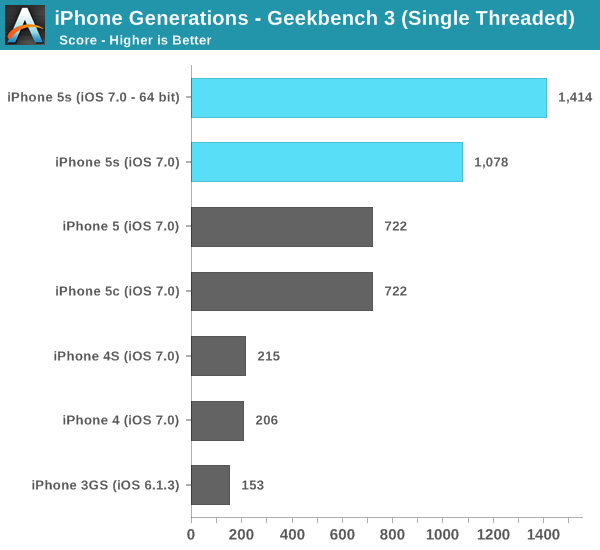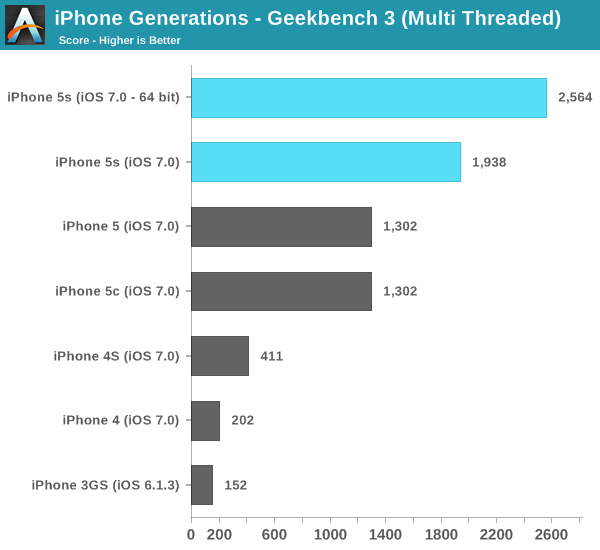The iPhone 5s Review
by Anand Lal Shimpi on September 17, 2013 9:01 PM EST- Posted in
- Smartphones
- Apple
- Mobile
- iPhone
- iPhone 5S
iPhone Performance Across Generations

Performance improved by a factor of 100x compared to the original iPhone. You can cut that in half if the iPhone could run iOS 4. Needless to say, Apple's CPU performance estimates aren't unreasonable. We've come a long way since the days when ARM11 cores were good enough.
Even compared to a relatively modern phone like the iPhone 4, the jump to a 5s is huge. The gap isn't quite at the level of an order of magnitude, but it's quickly approaching it. Using the single core iPhone 4 under iOS 7 just feels incredibly slow. Starting with the 4S things get a lot better, but I'd say the iPhone 4 is at the point now where it's starting to feel too slow even for normal consumers (at least with iOS 7 installed).

Browsermark 2.0 gives us a good indication of less CPU bound performance gains. Here we see over a 5x increase in performance compared to the original iPhone, and an 83% increase compared to the iPhone 4.
I wanted to have a closer look at raw CPU performance so I turned to Geekbench 3. Unfortunately Geekbench 3 won't run on anything older than iOS 6, so the original iPhone bows out of this test.

Single threaded performance scaled by roughly 9x from the 3GS to the iPhone 5s. The improvement since the iPhone 4/4S days is around 6.5x. Single threaded performance often influences snappiness and UI speed/feel, so it's definitely an important vector to scale across.

Take into account multithreaded performance and the increase over the 3GS is even bigger, almost 17x now.
The only 3D test I could get to reliably run across all of the platforms (outside the original iPhone) was Basemark X. Again I had issues getting Basemark X running in offscreen mode on iOS 7 so all of the tests here are run at each device's native resolution. In the case of the 3GS to 4 transition, that means a performance regression as the 3GS had a much lower display resolution to deal with.

Apple has scaled GPU performance pretty much in line with CPU performance over the years. The 5s scores 15x the frame rate of the iPhone 4, at a higher resolution too.
iPhone 5s vs. Bay Trail
I couldn't help but run Intel's current favorite mobile benchmark on the iPhone 5s. WebXPRT by Principled Technologies is a collection of browser based benchmarks that use HTML5 and js to simulate a number of workloads (photo editing, face detection, stocks dashboard and offline notes).

Granted we're comparing across platforms/browsers here, but the 5s as a platform does extremely well in Intel's favorite benchmark. The 5c by comparison performs a lot more like what we'd expect from a smartphone platform. The iPhone 5s is in a league of its own here. While I don't expect performance equalling the Atom Z3770 across the board, the fact that Apple is getting this close (with two fewer cores at that) is a testament to the work done in Cupertino.
At its launch event Apple claimed the A7 offered desktop class CPU performance. If it really is performance competitive with Bay Trail, I think that statement is a fair one to make. We're not talking about Haswell or even Ivy Bridge levels of desktop performance, but rather something close to mobile Core 2 Duo class. I've broken down the subtests in the table below:
| WebXPRT Performance (time in ms, lower is better) | ||||||
| Chrome/Mobile Safari | Photo Effects | Face Detection | Stocks | Offline Notes | ||
| Apple iPhone 5s (Apple A7 1.3GHz) | 878.9 ms | 1831.4 ms | 436.1 ms | 604.6 ms | ||
| Intel Bay Trail FFRD (Atom Z3770 1.46GHz) | 693.5 ms | 1557.0 ms | 542.9 ms | 737.3 ms | ||
| AMD A4-5000 (1.5GHz) | 411.2 ms | 2349.5 ms | 719.1 ms | 880.7 ms | ||
| Apple iPhone 5c (Apple A6 1.3GHz) | 1987.6 ms | 4119.6 ms | 763.6 ms | 1747.6 ms | ||
It's not a clean sweep for the iPhone 5s, but keep in mind that we are comparing to the best AMD and Intel have to offer in this space. I suspect part of why this is close is because both of those companies have been holding back a bit (there's no rush to build the fastest low margin parts), but it doesn't change reality.










464 Comments
View All Comments
Bragabondio - Thursday, September 19, 2013 - link
Great review. Anand is an Apple fanboy (meaning he is an active user of mac, iphone and ipad) so he has bias towards the ecosystem but his reviews are top notch regardless of his personal preferences. Although I do not necessary always agree with him I respect his technical acumen and his desire to look deeper and discover things that most casual observers miss.I would like to see an update on :
a) GPS - how the navigation has improved (or not) in ios7 perhaps testing it head to head vs. Nexus 4 or 5 (in case he has a prototype) during a ride;
b) speaker quality - this is subjective but perhaps at least loudness and is it mono or stereo
c) phone calls quality - yes this depends on the carrier but again a subjective evaluation would be appreciated.
A few comments on the actual review.
graphic tests
I love to see improvements in the graphics quality of ARM devices although I practically do not play games on my phone. Hopefully, Apple's example will push the industry towards faster development.
Missing AC Wi-Fi is a bummer
Regarding future-proofing I disagree with Amand it is not the CPU or GPU but the 4 inch screen is too small for web reading and the trend towards larger devices will continue thus unless you really like the screen and OS (I bet when Iphone 6 is revealed with 4.5 inch screen Anand will say that yes, it is hard to go back to iphone 5 :)
WoodyPWX - Wednesday, September 18, 2013 - link
For the web browsing battery life benchmark, it would be better to have also the number of reloads executed and the energy spent for one reload (computed from those two). There are two problems it could help solve. First, slow reloads caused by a slow connection most probably force CPU to sleep, so they actually save battery and favorize worse device. Second, faster CPU processes a web page much faster. It could draw more energy but for shorter time, so it would be a win in a normal situation. Unfortunately that's not the case in your benchmark, where another reload immediately follows. Energy spent on each reload could prove here on the 5s it will stay longer in real life situations and that's what I'm interested in.sfaerew - Wednesday, September 18, 2013 - link
you are right!jeffkro - Wednesday, September 18, 2013 - link
Looks kind of like the HTC one.joshjw - Saturday, September 21, 2013 - link
Well i think what you are trying to say is that the HTC one looks a lot like the Iphone because the 5s looks identical to the 5 except for the home button and the 5 was released before the HTC 1tipoo - Wednesday, September 18, 2013 - link
So what was up with the Infinity Blade 3 guys saying it loaded 5X faster on the 5S? How much faster is the NAND, exactly?Sabresiberian - Wednesday, September 18, 2013 - link
Apple, so far, has proved me wrong. I said they were going to be a cell phone dead end eventually a few years ago, but they have continued to innovate. The fact that they designed their own SoC has very much impressed me.I'm a PC guy, I'm a Windows guy; but I recognize a commitment to making a product better when I see one. Well done Apple!
If Microsoft wants to grab more smart phone market share, then they could do well to emulate Apple in this regard. Moral of the story here is - don't follow, lead!
slickr - Thursday, September 19, 2013 - link
Anand is a shill for the NSA, don't trust the retard. He is there to tell you to buy a spy system that scans your face, that scans your fingertip and has your full name and all other information.This is the NSA's dream, a spy device masquerading as phone that shills like Anand the retard push.
dugbug - Thursday, September 19, 2013 - link
Your tin foil budget must be quite largehulkkii - Thursday, September 19, 2013 - link
How fast is the camera compared to iPhone 5? (Can you test with CamSpeed)?